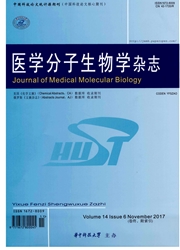

 中文摘要:
中文摘要:
目的将创造为理解 prion 蛋白质(PrP ) 的生理的功能和病理表示 hamster-PRNP 和 human-PRNP 为一个模型的转基因的老鼠,以及能递送的海绵状的 encephalopathies (TSE ) 的跨种类的传播的机制。方法仓鼠和 human-PRNP 转基因的老鼠被常规方法建立。在各种各样的老鼠线的综合 PRNP 的拷贝数字被即时 PCR 印射。PRNP mRNA 和蛋白质层次被半量的 RT-PCR,即时 RT-PCR,和西方的污点分析决定。转基因的老鼠的组织学的分析被染色的 hematoxylin 和曙红和 immunohistochemical (IHC )(H 与 E ) 执行方法。结果在各种各样的老鼠线的综合 PRNP 拷贝数字是 53 (Tg-haPrP1 ) , 18 (Tg-huPrP1 ) , 3 (Tg-huPrP2 ) ,并且 16 (Tg-huPrP5 ) 分别地。外长的 PrPs 在 transcriptional 和翻译水平被表示。组织学的试金没在大脑或另外的机关检测任何畸形。我们建立了一 hamster-PRNP 的结论转基因的老鼠线和三 human-PRNP 转基因的老鼠线。这四根转基因的老鼠线为另外的研究提供理想的模型。
 英文摘要:
英文摘要:
Objective To create transgenic mice expressing hamster- and human-PRNP as a model tor understanding the physiological function and pathology of prion protein (PrP), as well as the mechanism of cross-species transmission of transmissible spongiform encephalopathies (TSEs). Methods Hamster and human-PRNP transgenic mice were established by conventional methods. The copy number of integrated PRNP in various mouse lines was mapped by real-time PCR. PRNP mRNA and protein levels were determined by semi-quantitative RT-PCR, real-time RT-PCR, and western blot analysis. Histological analyses of transgenic mice were performed by hematoxylin and eosin (H & E) staining and immunohistochemical (IHC) methods. Results Integrated PRNP copy number in various mouse lines was 53 (Tg-haPrP1), 18 (Tg-huPrP1), 3 (Tg-huPrP2), and 16 (Tg-huPrP5), respectively. Exogenous PrPs were expressed at both the transcriptional and translational level. Histological assays did not detect any abnormalities in brain or other organs. Conclusion We have established one hamster-PRNP transgenic mouse line and three human-PRNP transgenic mouse lines. These four transgenic mouse lines provide ideal models for additional research.
 同期刊论文项目
同期刊论文项目
 同项目期刊论文
同项目期刊论文
 Mouse-adapted scrapie strains 139A and ME7 overcome species barrier to induce experimental scrapie i
Mouse-adapted scrapie strains 139A and ME7 overcome species barrier to induce experimental scrapie i Immune responses in wild-type mice against prion proteins induced using a DNA prime-protein boost st
Immune responses in wild-type mice against prion proteins induced using a DNA prime-protein boost st Raised levels of tau protein in CSF of Chinese patients with probable diagnostic Creutzfeldt-Jakob d
Raised levels of tau protein in CSF of Chinese patients with probable diagnostic Creutzfeldt-Jakob d The octarepeats of hamster PrP (PrP51-91) enhance the formation microtubule and antagonize Cu2+-indu
The octarepeats of hamster PrP (PrP51-91) enhance the formation microtubule and antagonize Cu2+-indu PrPSc of scrapie 263K propagates efficiently in spleen and muscle tissues with protein misfolding cy
PrPSc of scrapie 263K propagates efficiently in spleen and muscle tissues with protein misfolding cy Molecular interaction of TPPP with PrP antagonized the CytoPrP-induced disruption of microtubule str
Molecular interaction of TPPP with PrP antagonized the CytoPrP-induced disruption of microtubule str Familial CJD associated PrP mutants within transmembrane region induced retention of Ctm-PrP in ER a
Familial CJD associated PrP mutants within transmembrane region induced retention of Ctm-PrP in ER a A novel PrP partner HS-1 associated protein X-1 (HAX-1) protected the cultured cells against the cha
A novel PrP partner HS-1 associated protein X-1 (HAX-1) protected the cultured cells against the cha The epidemiological, clinical and laboratory features of sporadic Creutzfeldt-Jakob disease patients
The epidemiological, clinical and laboratory features of sporadic Creutzfeldt-Jakob disease patients The diversities of PrPSc distributions and pathologic changes in various brain regions from a Chines
The diversities of PrPSc distributions and pathologic changes in various brain regions from a Chines Comparative peptidome analyses of the profiles of the peptides ranging from 1 to 10 KD in CSF sample
Comparative peptidome analyses of the profiles of the peptides ranging from 1 to 10 KD in CSF sample Knocking-down of the levels of prion protein by RNA interference (RNAi) weakened the protective acti
Knocking-down of the levels of prion protein by RNA interference (RNAi) weakened the protective acti Remarkable reduction of MAP2 in the brains of scrapie-infected rodents and human prion disease possi
Remarkable reduction of MAP2 in the brains of scrapie-infected rodents and human prion disease possi Transient expressions of doppel and its structural analog prionΔ32-121 inSH-SY5Y cells caused cytoto
Transient expressions of doppel and its structural analog prionΔ32-121 inSH-SY5Y cells caused cytoto Molecular interaction of alpha-synuclein with tubulin influences onthe polymerization of microtubule
Molecular interaction of alpha-synuclein with tubulin influences onthe polymerization of microtubule Changes of tau profiles in brains of the hamsters infected with scrapie strains263K or 139A possibly
Changes of tau profiles in brains of the hamsters infected with scrapie strains263K or 139A possibly Manganese induced changes of the biochemical characteristics of therecombinant wild-type and mutated
Manganese induced changes of the biochemical characteristics of therecombinant wild-type and mutated Cytosolic prion protein induces apoptosis inhuman neuronal cell SH-SY5Y via mitochondrial disruption
Cytosolic prion protein induces apoptosis inhuman neuronal cell SH-SY5Y via mitochondrial disruption The propagation of hamster-adapted scrapie PrPSc can be enhanced by reduced pyridine nucleotide in v
The propagation of hamster-adapted scrapie PrPSc can be enhanced by reduced pyridine nucleotide in v Human prion protein mutants with deleted and inserted octarepeats undergo in different pathways to t
Human prion protein mutants with deleted and inserted octarepeats undergo in different pathways to t 期刊信息
期刊信息
